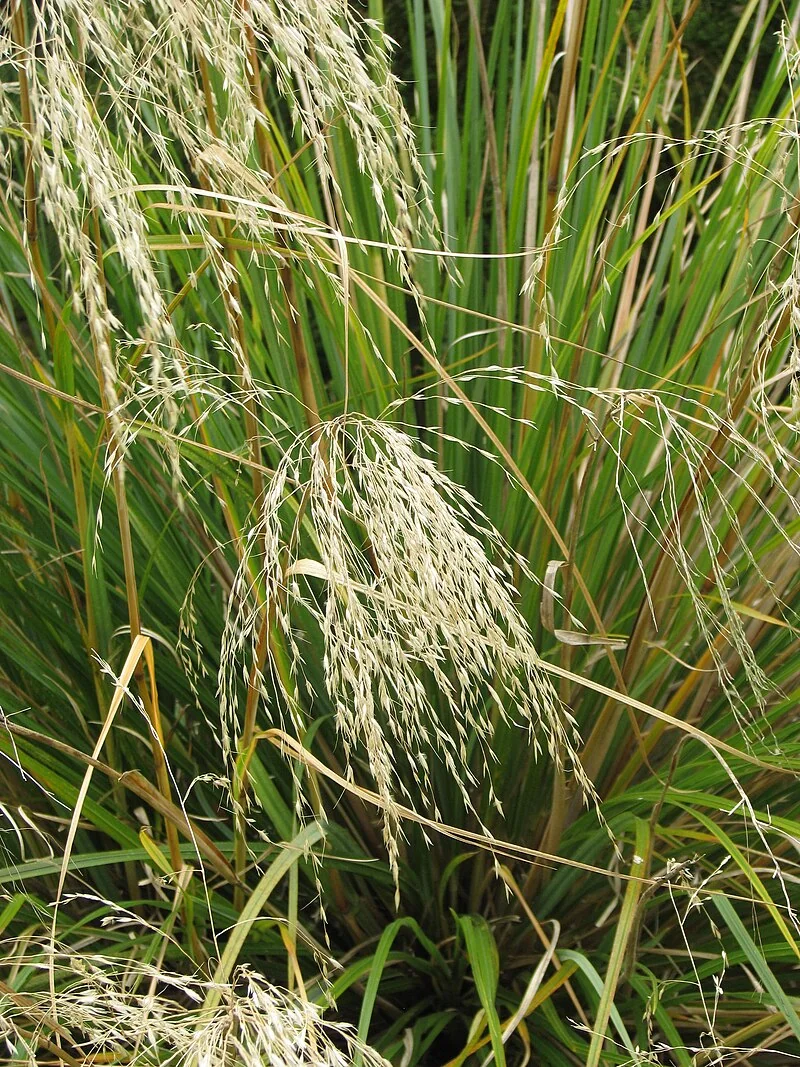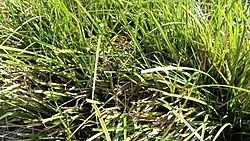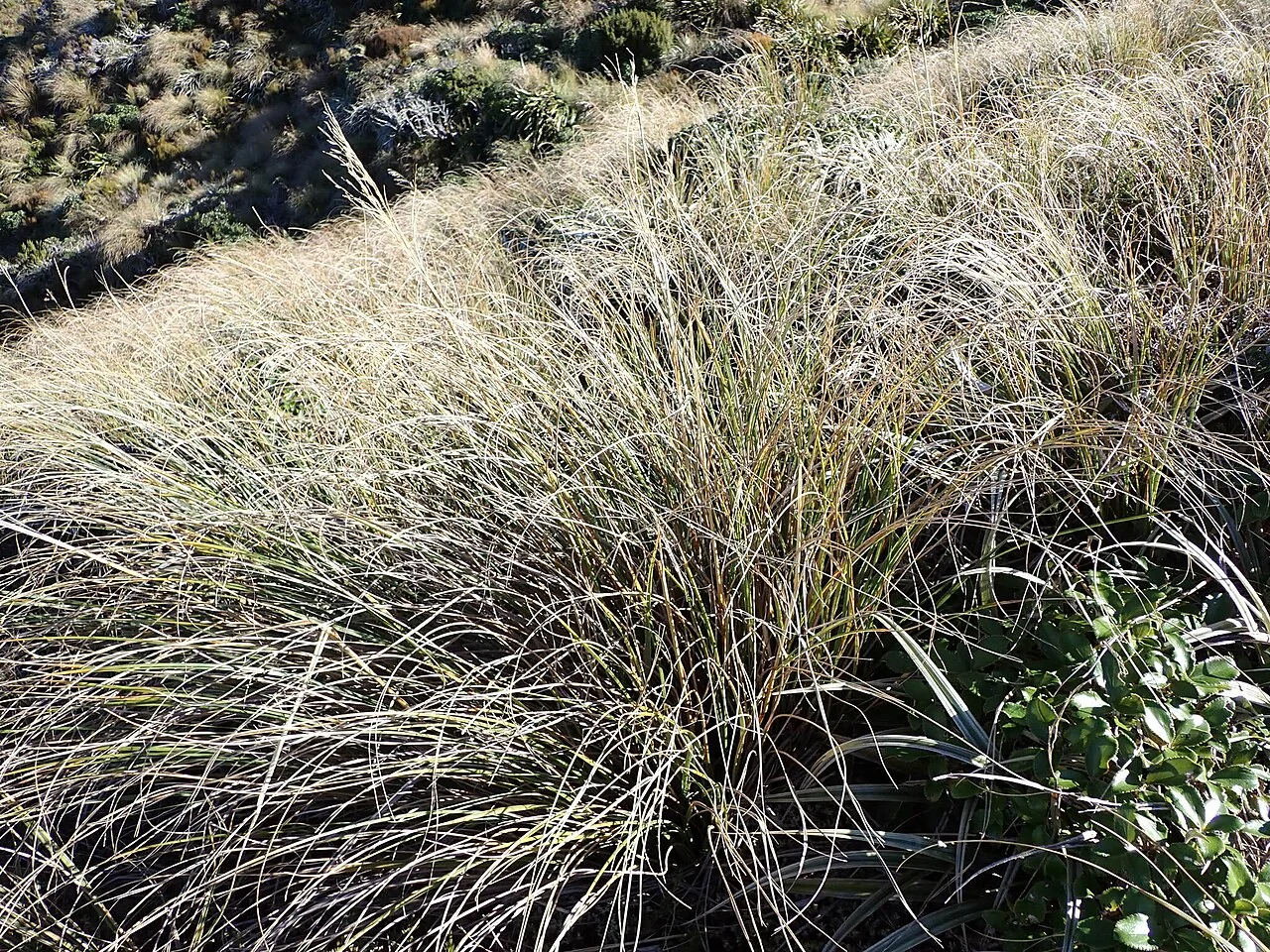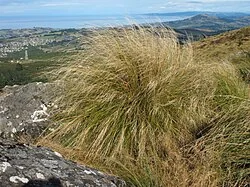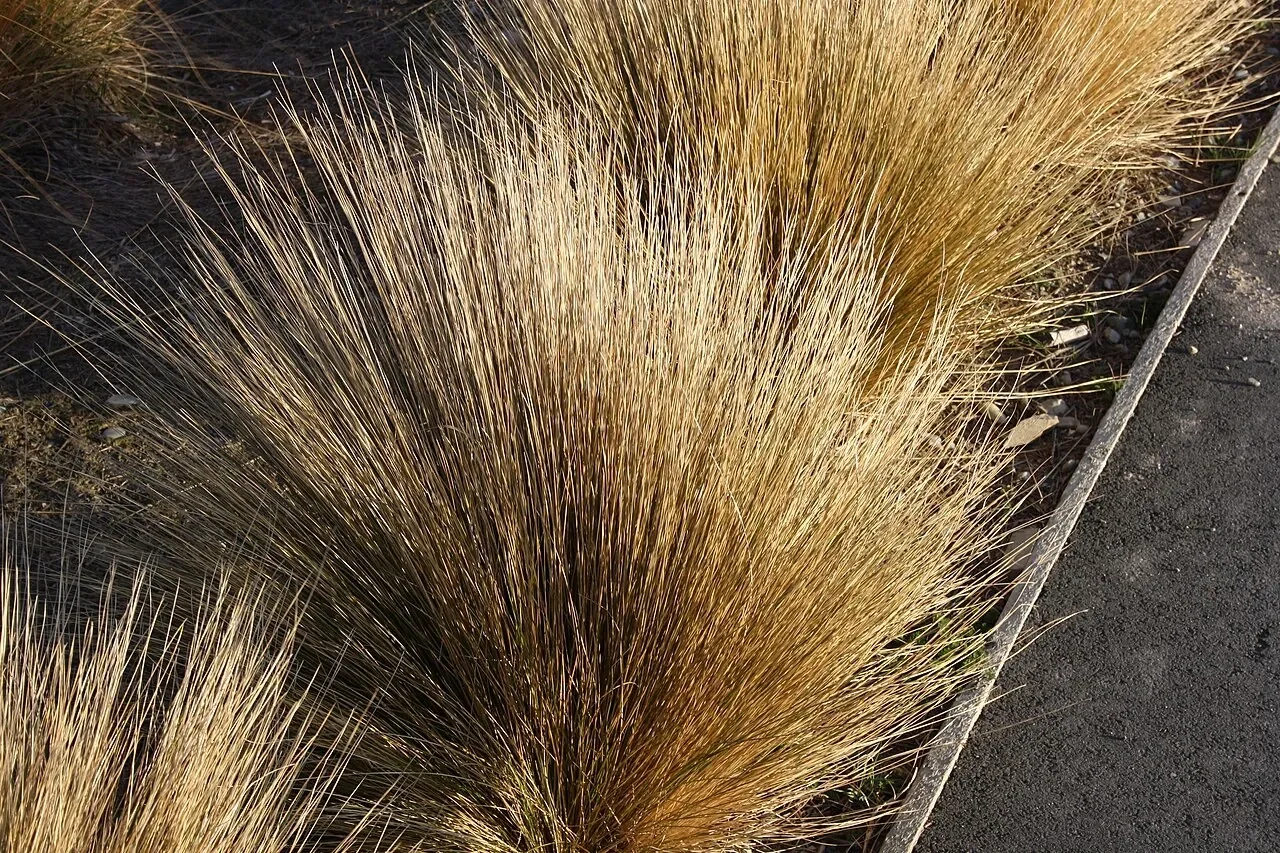
Red Tussock
Chionochloa rubra
Introduction
Overview
Red Tussock ( Chionochloa rubra ) is a majestic alpine grass renowned for its distinctive arching form and stunning reddish coloration that intensifies during cooler months. This hardy perennial creates dramatic architectural presence in landscapes with its fountain-like growth habit and feathery seed heads that dance gracefully in mountain breezes. As one of New Zealand's most recognizable tussock grasses, it plays a vital ecological role in high-country ecosystems while earning recognition from the Royal Horticultural Society for its outstanding ornamental value in cultivation.

Red Tussock (scientific name: Chionochloa rubra ) is a distinctive and hardy native grass endemic to New Zealand's alpine and subalpine regions. This robust perennial forms large, fountain-like clumps with gracefully arching leaves that display beautiful red and golden tones, particularly in autumn and winter. Found primarily in the South Island's mountainous areas, it creates dramatic landscapes and serves as an essential component of tussockland ecosystems. This remarkable native grass is prized for both its ecological importance and ornamental value in gardens.
Quick Facts
| Scientific Name | Chionochloa Rubra |
|---|---|
| Height | 60-120 cm |
| Spread | 80-150 cm |
| Water Needs | Low to moderate |
| Light | Full sun |
| Frost Tolerance | Excellent |
| Salt Tolerance | Moderate |
| Growth Rate | Moderate |
| Lifespan | Long |
Climate Best Suited to
Red Tussock ( Chionochloa rubra ) thrives in cool, moist alpine and subalpine climates typical of New Zealand's mountainous regions. This hardy native grass prefers cooler, less humid environments and can tolerate exposed, windy conditions. Found naturally from the Volcanic Plateau to Stewart Island, it performs best in areas with regular moisture and cool temperatures, making it ideal for high-altitude gardens and regions with similar climatic conditions.
Regional Suitability
| City | Climate Suitability |
|---|---|
| Whangārei | Ideal |
| Auckland | Ideal |
| Hamilton | Ideal |
| Tauranga | Ideal |
| Rotorua | Ideal |
| Gisborne | Ideal |
| New Plymouth | Ideal |
| Napier | Ideal |
| Whanganui | Ideal |
| Palmerston North | Ideal |
| Wellington | Ideal |
| Nelson | Ideal |
| Christchurch | Ideal |
| Dunedin | Ideal |
| Invercargill | Ideal |
Natural Habitat
Distribution and Environment
Chionochloa rubra , or Red Tussock, is endemic to New Zealand, primarily found in cool, moist alpine and subalpine climates of the mountainous regions. Its natural habitat extends from the Volcanic Plateau down to Stewart Island, ranging from the lower penalpine belt to sea level in the southern parts of the country. This hardy grass is often the dominant species in tall tussock grasslands and thrives in shallow bogs, along the margins of deeper bogs, small ponds, tarns, and slow-flowing streams. It can also be found in canopy gaps within upper montane forests or in subalpine scrub. It is highly adaptable to various soil conditions, including nutrient-poor, rich, moist, and well-drained alpine soils, and can tolerate seasonal waterlogging.
Plant Conservation
Chionochloa rubra , commonly known as red tussock grass, is a species of tussock grass endemic to New Zealand. It plays a vital ecological role in New Zealand's ecosystems by providing shelter and nesting sites for native birds, preventing erosion, regulating water flow in alpine catchments, and serving as a food source for native insects and herbivores.
Regarding its conservation status, specific subspecies have been assessed:
- Chionochloa rubra subsp. cuprea: Was assessed as "Not Threatened" in 2013, 2018, and 2023.
- Chionochloa rubra subsp. rubra var. rubra: Also has a "Not Threatened" conservation status.
Growing Requirements
Soil Requirements
Red Tussock ( Chionochloa rubra ) is remarkably adaptable to various soil conditions, thriving in everything from nutrient-poor soils to rich, moist ground. This hardy grass naturally grows in shallow bogs, alongside ponds and streams, and in well-drained alpine soils. It performs particularly well in damp, infertile soils but can adapt to drier conditions once established.
- Tolerates nutrient-poor soils extremely well
- Thrives in damp to wet soil conditions
- Adapts to well-drained alpine soils
- Performs well in boggy or marshy areas
- Can handle seasonal waterlogging near water features
Light Requirements
Red Tussock ( Chionochloa rubra ) performs best in full sun positions, which enhance its distinctive reddish coloration and promote healthy growth. However, it can tolerate partial shade, particularly in warmer climates where some protection from intense afternoon sun is beneficial. Its natural alpine habitat receives intense sunlight with cool air temperatures.
- Full sun for best coloration and growth
- Can tolerate partial shade in warmer regions
- At least 6 hours of direct sunlight daily preferred
- Benefits from protection in very hot climates
Water Requirements
Red Tussock ( Chionochloa rubra ) prefers consistent moisture and can handle both wet and relatively dry conditions. While it naturally grows in moist alpine environments and bog margins, once established it becomes quite drought-tolerant. However, it dislikes prolonged dry periods in hot, humid weather.
- Prefers consistent moisture throughout growing season
- Can tolerate wet conditions and seasonal flooding
- Drought-tolerant once established in cool climates
- Requires regular watering in warm, dry periods
- Dislikes hot, humid conditions combined with drought
Planting Guide
When to Plant
The best time to plant container-grown Chionochloa rubra is in spring and autumn when soil temperatures are moderate and rainfall is reliable. It can also be planted in summer if watered regularly during dry periods. Transplanting existing plants is best done from late spring to mid-summer.
Site Selection
Choose a site that mimics its natural alpine habitat:
- Light: Chionochloa rubra thrives in full sun, which enhances its distinctive reddish coloration and promotes healthy growth. It can tolerate partial shade, especially in warmer climates where some protection from intense afternoon sun is beneficial.
- Soil: This grass is adaptable to various soil conditions, including chalky, loamy, and sandy soils. It performs well in light, fertile, moist but well-drained soil. Good drainage is crucial, as it dislikes excessive winter wetness and soggy soil.
- Climate: It prefers cool, moist alpine and subalpine climates and dislikes high humidity. It has high frost tolerance and is suited to coastal and temperate conditions.
Planting Procedure
- Prepare the Soil: Dig a hole twice the width of the root ball and slightly deeper. Amend the soil with organic matter to improve drainage and fertility.
- Position the Plant: Carefully remove the plant from its container and place it in the hole, ensuring the top of the root ball is level with the soil surface.
- Backfill: Gently backfill the hole with soil, firming it lightly around the base of the plant.
- Water Thoroughly: Water the plant immediately after planting to help settle the soil.
- Mulch: Apply a layer of mulch around the base to retain moisture and suppress weeds.
Initial Care
Water deeply when the soil is dry to the touch, but avoid overwatering. Protect from rain and snow, but ensure it is well-watered. Regular mulching helps retain soil moisture and suppress weeds. Occasional feeding with a balanced fertilizer supports healthy growth and abundant flowering.
Ecological Significance
Chionochloa rubra , commonly known as Red Tussock Grass, holds significant ecological importance in New Zealand's ecosystems, particularly in alpine and subalpine regions. Its ecological roles are multifaceted and contribute to the overall health and resilience of these environments.
- Habitat and Shelter: The dense tussocks provide crucial shelter and nesting sites for native birds and insects, creating a microhabitat that protects them from harsh weather conditions and predators.
- Erosion Control: With its extensive and fibrous root systems, Chionochloa rubra effectively stabilizes soil and prevents erosion, especially in exposed and windy environments. This is vital for maintaining the integrity of alpine landscapes.
- Water Regulation: In alpine catchments, the tussocks play a role in regulating water flow by trapping and storing snow. This slow release of water helps to maintain stream flows during drier periods and reduces the risk of flooding.
- Food Source: It serves as an important food source for native insects and other herbivores, forming a key part of the alpine food web.
- Nutrient Cycling: The plant contributes to the cycling of nutrients within its ecosystem, helping to maintain soil fertility in often nutrient-poor alpine soils.
- Habitat Restoration: Chionochloa rubra is valuable for re-establishing natural habitats, particularly as a buffer plant around wetland areas and in tussock grassland restoration projects.
- Adaptability: This species is highly adaptable, thriving in exposed and windy conditions, and capable of growing in low-nutrient soils as well as both relatively wet and dry environments. This resilience makes it a cornerstone species in many alpine plant communities.
- Dominant Species: It is often the dominant species in tussock grasslands and can be found in shallow bogs, tarns, and along the margins of slow-flowing streams, defining the character of these landscapes.
Uses and Significance
Garden Uses
- Excellent specimen plant for alpine and rock gardens
- Outstanding for water garden margins and bog gardens
- Provides year-round structural interest in mixed borders
- Effective for erosion control on slopes and banks
- Ideal for contemporary and naturalistic garden designs
Landscaping Uses
Garden Design Applications
Chionochloa rubra , commonly known as Red Tussock, is a versatile and popular New Zealand native grass highly valued in landscaping for its striking appearance and low maintenance. Its distinctive coppery-bronze foliage and graceful, arching form add significant colour, texture, and movement to a landscape.
- Mass Plantings and Ground Cover: Red Tussock is frequently mass-planted to create an effective ground cover or to make a dramatic statement in large gardens and naturalistic designs. When planted 80 cm apart, the plants merge to form a cohesive ground cover.
- Borders and Mixed Plantings: Its elegant arching lines make it suitable for inclusion in borders, where it combines well with other plants, or in mixed plantings to provide textural contrast.
- Around Outdoor Living Areas: It's a popular choice for planting around pools and barbecue areas, adding a natural and softening element to these spaces.
- Commercial Landscapes: Its hardiness and low maintenance make it ideal for gardens around commercial buildings that may receive less attention.
- Various Garden Styles: Chionochloa rubra can be incorporated into a wide range of garden styles, including naturalistic, contemporary, coastal, cottage gardens, and prairie plantings. It also fits well in architectural, backyard, city and courtyard, Mediterranean, modern, and riparian garden styles.
- Erosion Control: Ecologically, it's beneficial for erosion control, especially in exposed and windy areas, due to its dense root system.
- Habitat Restoration: It aids in re-establishing native habitats and provides shelter and nesting sites for native birds and insects, contributing to biodiversity.
- Year-Round Interest: As an evergreen perennial, it offers year-round visual appeal. Its leaves maintain their colour, with winter bringing beige tips and coppery tones at the bases, adding colour to the colder months.
- Container Planting: It can also be used effectively in containers, where its arching foliage can be appreciated up close.
Seasonal Care Calendar
Spring
In spring, Red Tussock ( Chionochloa rubra ) begins its active growth phase with new shoots emerging from the base. This is an ideal time for planting new specimens or dividing established clumps. Fresh growth appears bright green before developing the characteristic reddish tones. Apply a light dressing of balanced fertilizer if growth appears weak.
- New growth emerges from base of established clumps
- Excellent time for planting and division
- Apply light fertilizer if growth appears weak
- Fresh seed can be sown for propagation
Summer
Summer is the peak growing season for Red Tussock ( Chionochloa rubra ), with flowering typically occurring from October to December. The grass develops its characteristic fountain-like form and begins to show reddish coloration. Ensure adequate moisture during dry periods, particularly in warmer climates where the plant may struggle.
- Peak growing season with flowering (October-December)
- Develops characteristic fountain-like form
- Reddish coloration begins to develop
- Maintain adequate moisture in dry periods
Autumn
During autumn, Red Tussock ( Chionochloa rubra ) reaches its most spectacular appearance as the foliage develops intense reddish and golden tones. Seed heads mature and can be collected for propagation. This is another good planting time as temperatures cool and conditions become more favorable.
- Peak colour development with intense red and gold tones
- Seed heads mature (fruiting November-May)
- Excellent time for planting as temperatures moderate
- Collect seed for propagation purposes
Winter
Winter is a relatively dormant period for Red Tussock ( Chionochloa rubra ), though the plant remains evergreen and provides structural interest. The reddish coloration is often most intense during cold months. The plant is extremely cold-hardy and requires no winter protection, even in harsh alpine conditions.
- Dormant period but remains evergreen
- Reddish coloration often most intense
- Excellent cold tolerance requires no protection
- Provides valuable winter garden structure
When to Prune and How Much
Red Tussock ( Chionochloa rubra ) requires minimal pruning to maintain its natural fountain-like form. Most maintenance involves removing dead or damaged foliage and old flower heads. The grass naturally maintains its shape and density without regular cutting.
- Remove dead or damaged leaves from the base as needed
- Cut back old flower heads after seed collection if desired
- No regular pruning required - maintains natural form
- Avoid cutting the entire plant back hard
- Can be lightly groomed in late winter if necessary
- Remove any brown or damaged tips for tidiness
Always use clean, sharp tools when removing any plant material. The grass naturally renews itself from the base, and heavy pruning can damage or stress the plant. Light maintenance is all that's typically required.
How to Grow Red Tussock
From Seed
Red Tussock ( Chionochloa rubra ) sets abundant, fine seed on its copper-gold plumes. To maximise results, collect inflorescences as they dry in late summer to autumn and place them in a paper bag to finish ripening; rub out the seed and gently winnow away chaff. Use a very free-draining seed-raising mix (for example, two parts fine compost to one part coarse sand or pumice) and surface-sow or barely cover, because small grass seed benefits from light and good air exchange at the surface. A firmed, level surface helps even moisture and contact. Maintain bright light with excellent airflow, and keep the surface just moist with a fine mister; avoid saturating the medium, which promotes damping-off. Cool to mild temperatures around 12-20 °C are suitable. Germination is often staggered over 3-6+ weeks, with fresh seed generally faster. Once the first true leaves form, prick out seedlings into tubes containing a gritty, lean mix and grow on in full sun with regular but light watering. Feed sparingly: excessive nutrition leads to lush, floppy growth and poorer clump structure. Harden off gradually before planting into their final position. Choose open, sunny sites with sharp drainage; raised berms, banks, or gravelly soils suit this species well. In higher-rainfall districts, spacing to encourage air movement helps keep foliage clean.
- Collect ripe seed from mature flower heads in late summer to autumn
- Use fresh seed immediately for best germination rates
- Sow seed in a well-draining seed-raising mix
- Surface sow or barely cover with fine soil
- Keep growing medium consistently moist but not waterlogged
- Maintain cool, humid conditions for germination
- Germination typically occurs within 2-6 weeks
- Transplant seedlings when large enough to handle
Seedlings are slow-growing initially but develop into robust plants with patience.
Division of Whole Plants
Division refreshes older clumps and produces plantable units quickly. Tussocks have dense, fibrous bases; use two garden forks back-to-back or a sharp spade/saw to split the crown into several firm pieces, each with vigorous roots and multiple growing points. Best timing is early spring as new growth begins, or early autumn while soil warmth remains. Trim away dead thatch and any damaged roots, then replant divisions immediately into prepared, free-draining ground or pots of gritty mix. Water to settle, then water sparingly while roots knit: prolonged wet around the crown can cause rot. In exposed sites, staking or temporary wind shelter helps prevent rocking until well rooted. Expect divided plants to take a season to regain full stature; thereafter they resume strong, arching form.
- Best done in spring as new growth emerges
- Carefully lift the entire clump from the soil
- Use a sharp spade or saw to divide into sections
- Ensure each division has adequate roots and growing points
- Plant divisions immediately in prepared soil
- Keep well-watered until established
- Divisions may take time to recover and establish
Growing from Tillers
Many mature tussocks produce peripheral tillers that can be detached with a small portion of basal tissue and roots. Select robust, well-anchored shoots from the outer edge; loosen soil, work a hand trowel beneath, and lift with as many roots as possible. Pot into a coarse, fast-draining medium and keep in bright light with modest watering until new growth indicates establishment, then harden off to full sun. This method is useful for increasing numbers from particularly well-coloured or well-formed specimens and is often less disruptive than splitting the whole crown.
- Identify healthy tillers with their own root systems
- Carefully dig around the tiller to expose roots
- Cut cleanly from the parent plant with sharp tools
- Plant immediately in well-prepared soil
- Provide shelter and consistent moisture until established
- Growth may be slow initially but will accelerate once established
Pests and Diseases
Chionochloa rubra , commonly known as Red Tussock Grass, is generally a robust and adaptable plant with few significant pest or disease issues, particularly in garden settings. However, some specific problems have been identified.
Pests
- Insects affecting flowers and seeds: The flowers of Chionochloa grasses, including C. rubra , can be attacked by certain insects. These include the fly Diplotoxa similis , which lays eggs in the flowers, with larvae consuming them, and another unclassified cecidomyiid fly that lays eggs in the pollen. Additionally, the moth Megacraspedus calamogonus has caterpillars that appear early in the season and feed on florets. These insect activities can lead to a significant reduction in seed production, sometimes causing complete destruction in localized areas.
- Grazing animals: While wild horses, cows, and rabbits graze in areas where red tussock grows, the grass typically continues to thrive despite their presence.
- Mealybugs: Although not specifically highlighted as a common problem for Chionochloa rubra , mealybugs are general plant pests that can suck sap and weaken plants.
Diseases
Chionochloa rubra is largely disease-free. Most issues related to plant health are often a result of unsuitable growing conditions rather than specific pathogens.
- Fungal diseases: These can occasionally occur if the plant is in soil that is excessively wet or poorly drained. Ensuring good air circulation and avoiding overwatering are recommended preventative measures.
- Waterlogging: The plant is intolerant of excessive winter wetness. Waterlogged soil can lead to fungal infections, such as those caused by Phytophthora and Pythium , which can affect the plant's vascular system and cause wilting.
Cultural Significance
Traditional Uses and Values
Red Tussock ( Chionochloa rubra ) holds important cultural significance in traditional Māori life, particularly in the South Island. Historical accounts describe how Māori used tussock grass to make protective leggings (called patiti) that shielded bare legs from the sharp speargrass during mountain travel. The grass was also placed in traditional sandals (paraerae) to provide insulation and warmth, especially when wading through cold alpine waters.
Bonus Tip
Expert Growing Advice
Red Tussock ( Chionochloa rubra ) is an incredibly resilient and adaptable plant, often thriving in harsh alpine environments where few other plants can survive. Its distinctive reddish coloration intensifies during cooler months, providing year-round visual interest. This makes it an excellent choice for low-maintenance, naturalistic gardens, especially in cooler climates, where it can add dramatic architectural form and colour.

